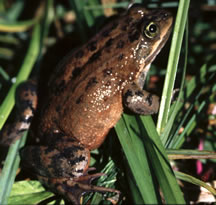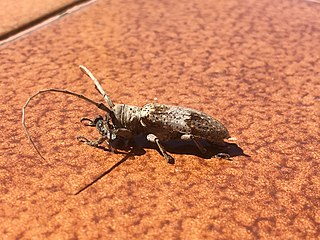The Spanish Gypsy is an English Jacobean tragicomedy, dating from around 1623. The play was likely a collaboration between several dramatists, including Thomas Middleton, William Rowley, Thomas Dekker, and John Ford. Like Shakespeare's lost play Cardenio, The Spanish Gypsy is an English reworking of the novellas of Miguel de Cervantes, combining two of Cervantes' Novelas Ejemplares into a single drama.
Petrus Bonus was a late medieval alchemist. He is best known for his Precious Pearl or Precious New Pearl, an influential alchemical text composed sometime between 1330 and 1339. He was said to have been a physician at Ferrara in Italy, causing him to sometimes be known as Petrus Bonus of Ferrara or as Petrus Bonus the Lombard. An Introduction to the Divine Art is also attributed to him but was printed much later, in 1572.

The Oregon spotted frog is a member of the frog family Ranidae of order Anura. It is a medium-sized aquatic frog endemic to the Pacific Northwest and historically well distributed in the Puget Trough/Willamette Valley province and the Cascade Mountains of south-central Washington and Oregon. It is relatively rare within its range and is listed globally as vulnerable.

Wallisia pretiosa is a species of plant in the family Bromeliaceae. It is endemic to Ecuador. Its natural habitats are subtropical or tropical moist lowland forests and subtropical or tropical moist montane forests.

Branchiocaris is an extinct genus of Cambrian bivalved arthropod. The type and best known species, Branchiocaris pretiosa, was described from the Burgess Shale of British Columbia, Canada, in 1929, originally placed in Protocaris, and was placed into its own distinct genus by Briggs in 1976. Several other possible species have been described from Cambrian deposits in China, and it is also possibly known from Cambrian deposits in Utah. Branchiocaris pretiosa is around 80–90 millimetres (3.1–3.5 in) in length, with a highly segmented trunk, consisting of at least 44 ring-like segments, terminating in a forked tail telson. At the front of the animal is a pair of short segmented tapered antennules with at least 20 segments, as well as a pair of claw appendages. It was likely an active swimmer, and used the claw appendages to bring food to the mouth.

Catocala pretiosa, the precious underwing, is a moth of the family Erebidae. The species was first described by Joseph Albert Lintner in 1876. It was included in Catocala crataegi by many authors, but recently it has been revalidated as a distinct species. The subspecies of pretiosa is listed as a species of special concern and believed extirpated in the US state of Connecticut.

Oncideres cingulata, the twig girdler, is a brownish-gray beetle, typically 1⁄2 to 5⁄8 inch in length, in the longhorn beetle family. It is characterized by long antennae, 1⁄2 to 1 inch long.

Imbricaria pretiosa, common name the splendid mitre, is a species of sea snail, a marine gastropod mollusk in the family Mitridae, the miters or miter snails.

Onciderini is a tribe of longhorn beetles of the subfamily Lamiinae, they are prevalent across Europe in nations such as Turkey, and Finland.

Oncideres is a genus of longhorn beetles of the subfamily Lamiinae, containing more than 120 species in the nearctic and neotropics.
Oncideres sparsemaculatus is a species of beetle in the family Cerambycidae. It was described by Martins and Galileo in 2010. It is known from Guatemala.

Oncideres putator is a species of beetle in the family Cerambycidae. It was described by James Thomson in 1868.

Oncideres albomarginata is a species of beetle in the family Cerambycidae. It was described by James Thomson in 1868. It is known from Costa Rica, Ecuador, Colombia, Guatemala, Panama, Guyana, Mexico, Nicaragua, Venezuela, and Trinidad and Tobago.
Oncideres chevrolatii is a species of beetle in the family Cerambycidae. It was described by James Thomson in 1868. It is known from Brazil.

Oncideres captiosa is a species of beetle in the family Cerambycidae. It was described by Martins in 1981. It is known from Paraguay and Brazil.

Oncideres gutturator is a species of beetle in the family Cerambycidae. It was described by Johan Christian Fabricius in 1775. It is known from Ecuador, Brazil, Guyana, Suriname, Panama, and French Guiana.
Phytoecia pretiosa is a species of beetle in the family Cerambycidae. It was described by Faldermann in 1837. It is known from Syria, Azerbaijan, Iraq, Armenia, Iran, Turkey, and possibly Georgia. It feeds on Onopordum carduchorum.

Tragocephala pretiosa is a species of beetle in the family Cerambycidae. It was described by Hintz in 1909. It is known from Tanzania, Malawi, Kenya, and Zambia.
Chalcosia pretiosa is a moth in the family Zygaenidae. It was described by Francis Walker in 1865 from Sri Lanka. Two subspecies are recorded.

Nixonia is a genus of wasps. It is the only member of the family Nixoniidae in the superfamily Platygastroidea. They are amongst the largest of the platygastroids at up to 9 mm in length. Members of the genus are known from Africa, the Indian subcontinent and Southeast Asia. The biology of only one species is known, which parasitizes orthopteran eggs.











